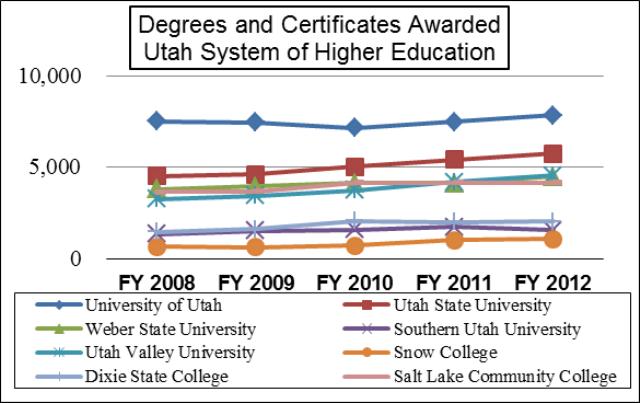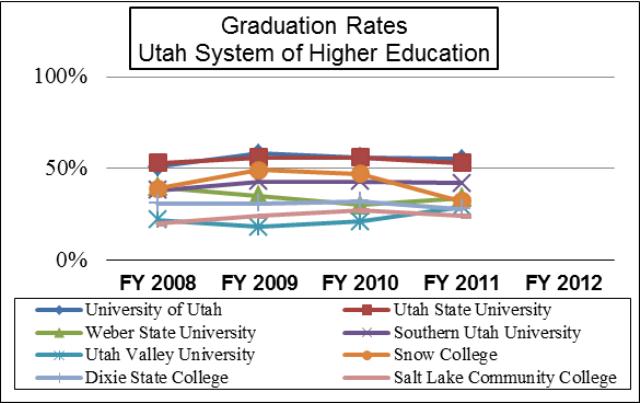Compendium of Budget Information for the 2013 General Session
| Higher Education Appropriations Subcommittee | ||||||||||||||||||||||||||||||||||||||||||||||||||||||||||||||||||||||||||||||||||||||||||||||||||||||||||||||||||||||||||||||||||||||||||||||||||||||||||||||||||||||||||||||||||||||||||||||||||||||||||||||||||||||||||||||||||||||||||||||||||||||||||||||||||||||||||||||||||||||||||||||||||||||||||||||||||||||||||||||
| <-Foreword | Subcommittee Table of Contents | Next Page-> | ||||||||||||||||||||||||||||||||||||||||||||||||||||||||||||||||||||||||||||||||||||||||||||||||||||||||||||||||||||||||||||||||||||||||||||||||||||||||||||||||||||||||||||||||||||||||||||||||||||||||||||||||||||||||||||||||||||||||||||||||||||||||||||||||||||||||||||||||||||||||||||||||||||||||||||||||||||||||||||||
Background The Higher Education Appropriations Subcommittee makes budget recommendations to the Executive Appropriations Committee and the whole Legislature in the following areas:
The Utah System of Higher Education (USHE) is comprised of nine institutions of higher learning: eight credit-granting institutions which are governed by the State Board of Regents with the assistance of local Boards of Trustees and the Utah College of Applied Technology, a non-credit granting college that provides career and technical education, governed by its own Board of Trustees. The following is a list of the institutions by type: Research Universities The University of Utah (U of U) is considered the flagship institution of the USHE. As a major urban teaching and research university, the University of Utah's mission is to provide undergraduate, graduate, and professional education, as well as significant programs of sponsored research, in 15 colleges and professional schools including medicine, pharmacy, and law. Utah State University (USU) serves as the State's land-grant university. Utah State University's mission is to provide undergraduate, graduate, professional, and research curriculums in numerous fields of study, including agriculture, applied sciences, education, and natural resources. Utah State University also has the statewide role of providing education to under-served areas throughout the state through on-site delivery and distance education at its comprehensive regional college (formerly College of Eastern Utah), four continuing education campuses, and county extension offices. Regional/Comprehensive Universities Weber State University (WSU) has the mission of a large, comprehensive regional undergraduate institution seeking to develop and refine programs and achieve distinction within that mission. Weber State University provides undergraduate education in the arts, humanities, and sciences, as well as professional study in education, business, and technology. Weber State University, through two branch campuses and various outreach programs, offers specialized certificates in applied technology education, associate's degrees, bachelor's degrees, and a limited number of master's degrees. Southern Utah University (SUU) has the mission of a four-year undergraduate teaching institution meeting the associate, baccalaureate and assigned vocational education needs of the southern part of the State. Southern Utah University also offers select graduate programs. Utah Valley University (UVU) transitioned to a university on July 1, 2008, following the passage of Senate Bill 70, which was approved during the 2007 General Session. UVU is a teaching institution which promotes student success while meeting regional educational needs. UVU offers a range of degrees from certificates through master's degrees. UVU's main campus is in Orem, with a satellite campus in Heber City. State College Dixie State College (DSC) is a state college comprised of two interdependent divisions. The lower division embraces and preserves the philosophy and mission of a comprehensive community college offering general and applied technology education. The upper division offers a limited number of baccalaureate degrees. Students are able to complete specialized certificates in applied technology education, associate's degrees, and some bachelor's degrees at Dixie State College. Community Colleges Snow College (SC) provides high quality general education and academic transfer courses along with career and technical education (CTE). Snow College offers Associate of Arts, Associate of Sciences, Associate of Applied Science and Associate of Applied Technology degrees. Snow College has a main campus located in Ephraim and a branch campus in Richfield. During the 2003 General Session, House Bill 161, "Snow College Richfield Campus," transferred the operations of the Utah College of Applied Technology's Central Campus to Snow College. Because of this change, Snow offers CTE programs to secondary and post-secondary students in the region. Salt Lake Community College (SLCC) is a multi-campus, open-door, comprehensive community college serving a diverse urban population. The College, with its 13 urban campus sites, is committed to providing a full range of educational experiences with an emphasis on applied technology education, academic, developmental, and community education and training to meet the social and economic needs of business and industry as well as the community. Career and Technical College Utah College of Applied Technology (UCAT) with its eight regional campuses located throughout the State provides career and technical education (CTE) to meet the social and economic needs of the State. It strives to do so efficiently and effectively through collaborative partnerships between the educational systems, and business and industry. UCAT offers quality educational programs and innovative delivery systems to ensure a skilled and educated workforce. The delivering institutions offer open-entry/open-exit, high quality, competency-based training for secondary and post-secondary students. All eight UCAT campuses have recently received accreditation from the Council on Occupational Education. Utah Medical Education Program The enactment of House Bill 141, "Medical Education Program," in the 1997 General Session, created the Medical Education Program to be administered by the Utah Medical Education Council (UMEC). The UMEC is presided by an eight-member board appointed by the Governor. The UMEC evaluates current and future healthcare workforce needs, measures and promotes retention rates, stabilizes funding for training, and recommends policies to achieve a viable healthcare workforce. The UMEC helps promote a public/private partnership by working closely with the healthcare industry and the university and college medical education programs. Some of the issues that the Higher Education Appropriations Subcommittee has discussed over the past two years include: Mission-Based Funding, Equity, Completion Rates, Using Technology to Improve Results, and College Preparedness. Mission-Based Funding has provided direction (through SB 97, 2011 General Session) and funding to encourage institutions to emphasize their specific mission and become more effective in providing educational programs that fit that mission. Equity funding is in response to an independent study which determined that USHE institutions should be less reliant on tuition funding and receive additional state support. Funding was approved for FY 2013 and was distributed according to the study's recommendation to seven of the USHE institutions and USU's regional campuses. Completion rates look at how many first-time, full-time students complete their degree in a given time period. Discussions have centered on how to increase this rate by having more students graduate and achieve this more quickly. Many factors affect whether a student will graduate and if they are able to do so in a timely manner. Reports indicate that the longer a student takes to graduate, the less likely that student is to complete the graduation requirements. One way to increase the completion rates uses technology, such as the Technology-Intensive Concurrent Enrollment core courses developed by the Board oif Regents to help high school students complete requirements prior to entering college. The Subcommittee has discussed college readiness. Studies prove that higher school students who are prepared for higher education are more successful than students who are not as prepared. The Legislature approved the development of an online tool to assist high school students to determine their readiness and provide resources in areas where the student may need remediation assistance. Statutory Authority The following laws govern the operations of the Utah System of Higher Education:
Intent Language For FY 2013, USHE institutions received a total of $4 million for "Mission Based Funding" together with intent language directing that consideration for expenditures from this funding should include: tracking of student plans and student progress; requiring students to take general education courses early in their college experience; increasing the availability of courses; holding down increases in tuition, fees, and books; and improving retention and completion measures. Performance The following graphs show the degrees conferred and the graduation rates at each USHE institution. More detailed information can be foound in each institution's Education and General line item. 
 Funding Detail During the 2012 General Session, the Legislature appropriated a total budget of $1,351,669,100 for FY 2013, which includes $410,244,900 from the General Fund and $325,316,300 from the Education Fund. Table 1: Operating and Capital Budget Including Expendable Funds and Accounts
| ||||||||||||||||||||||||||||||||||||||||||||||||||||||||||||||||||||||||||||||||||||||||||||||||||||||||||||||||||||||||||||||||||||||||||||||||||||||||||||||||||||||||||||||||||||||||||||||||||||||||||||||||||||||||||||||||||||||||||||||||||||||||||||||||||||||||||||||||||||||||||||||||||||||||||||||||||||||||||||||
| <-Foreword | Next Page-> |
COBI contains unaudited data as presented to the Legislature by state agencies at the time of publication. For audited financial data see the State of Utah's Comprehensive Annual Financial Reports.